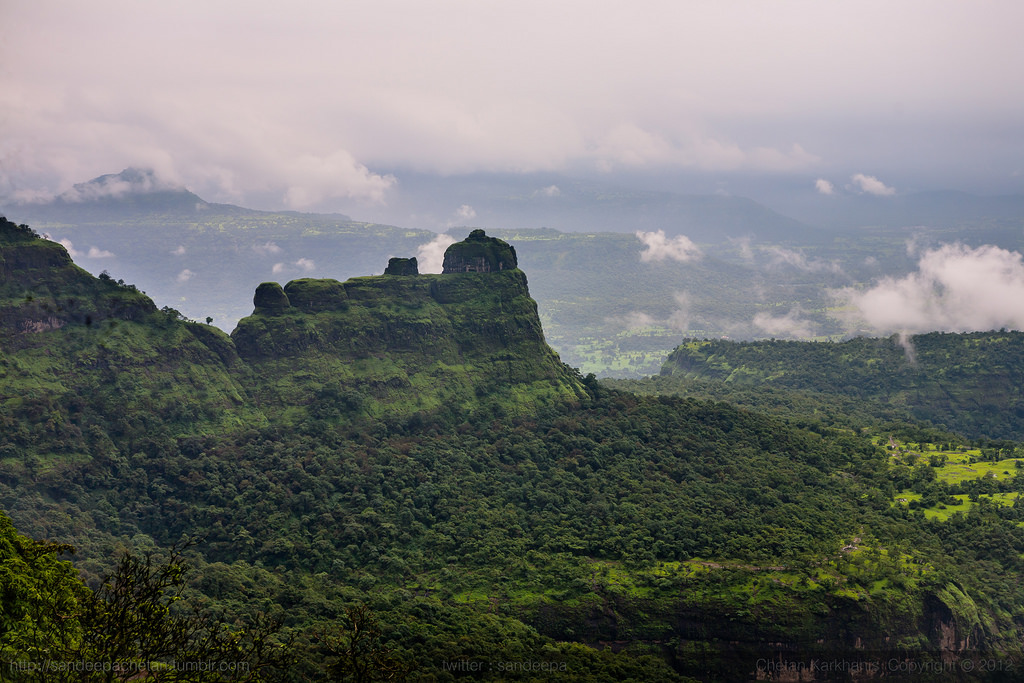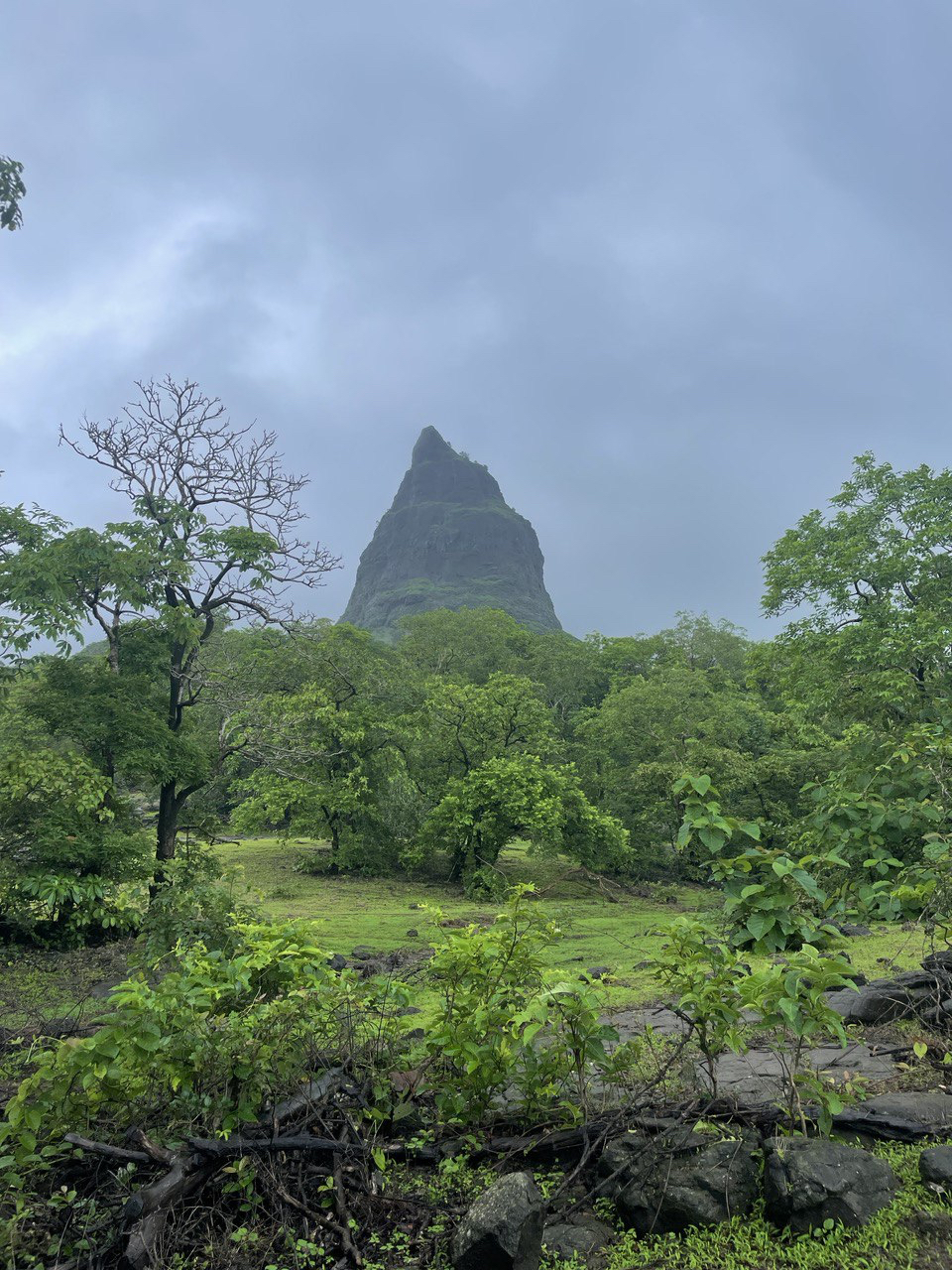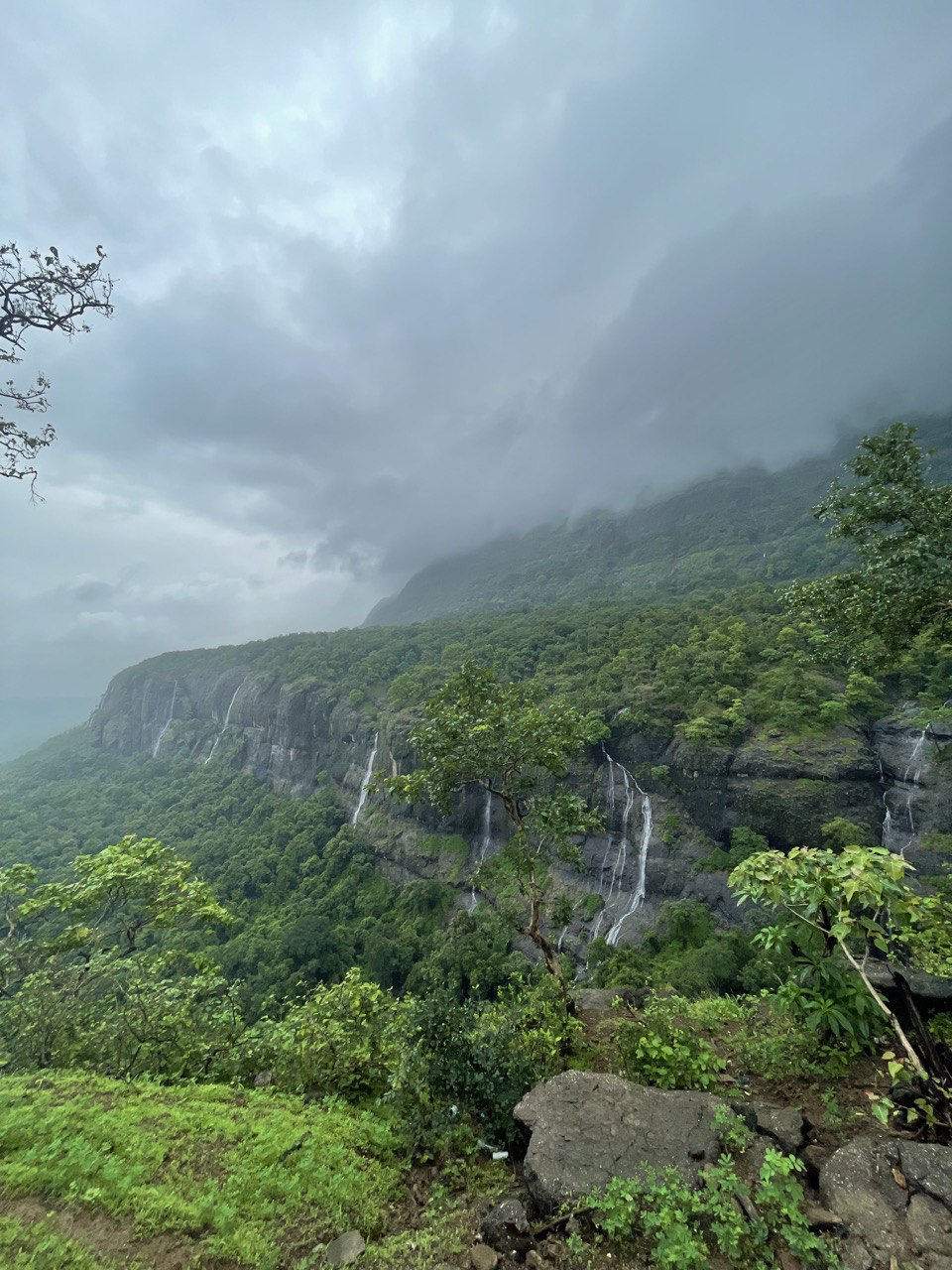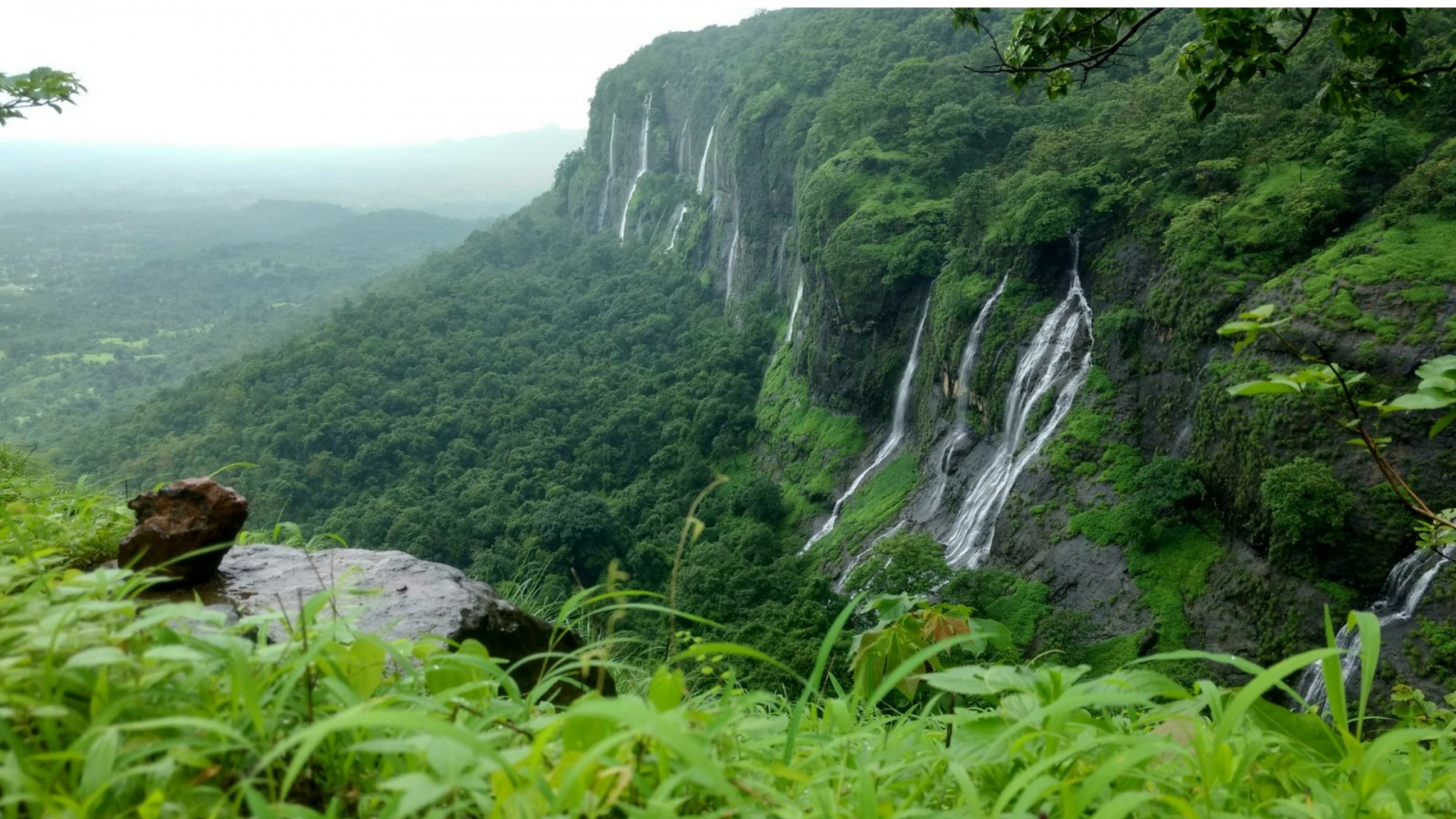Hidden Waterfall
Distance from Campsite – 12 kms by vehicle 1 km by foot
Imagine a remote mountain range covered in lush greenery, with tall, majestic trees and vibrant foliage. The air is crisp and fresh, carrying the scent of pine and damp earth. As you navigate through the dense forest, you come across a narrow trail that leads you deeper into the mountains.
The trail meanders alongside a babbling brook, its clear waters sparkling in the sunlight. You can hear the soothing sound of rushing water as you make your way up the path. After a short hike, you notice a change in the soundscape—a distant roar growing louder with each step.
Curiosity piqued, you follow the sound until you reach a hidden clearing. The view takes your breath away. Towering rock formations flank a narrow gorge, where a pristine waterfall cascades down from above, creating a shimmering curtain of water. The falls plunge into a crystal-clear pool, its surface disturbed only by gentle ripples.
Surrounding the waterfall are moss-covered boulders, adorned with ferns and wildflowers. The vibrant greens and colorful blossoms create a striking contrast against the rugged rocks. Sunlight filters through the dense canopy above, casting dappled light and creating a magical atmosphere.
You find a secluded spot to sit and soak in the tranquility. The gentle mist from the waterfall cools the air, creating a refreshing oasis amidst the mountain’s embrace. You can’t help but feel a deep sense of awe and appreciation for the hidden beauty nature has bestowed upon this place.
As you eventually depart from this hidden waterfall in the greenery mountains, you carry with you the memories of its ethereal beauty, its calming sounds, and the serenity that enveloped you during your visit.
Padargad Fort
Padargad Fort, is a small fort located in Karjat mountain range of Maharashtra, India. Situated in the Bhimashankar trek route, the fort stands at an elevation of approximately 4,490 feet above sea level.
History-
Padargad Fort holds immense historical significance and offers breathtaking views of the surrounding landscapes. It is believed to have been built during the Maratha Empire era, primarily serving as a watch tower to overlook the Mawal area. Aurangzeb used this fort to gain control over the Peth Fort.
Route, Brief and Difficulty level-
It is not frequented by trekkers similar to other reknown forts in and around Mumbai, thanks to its lesser known route, chimney climbing, moderate level climb.
Since, Padargad fort lies in the Bhimashankar range, Padargad and Bhimashankar have the same base village of Khandas village. In fact half the trek route for Padargad till a well is same as Bhimashankar Ganesh Ghat route.
From the well left goes to Bhimashankar & right goes to Padargad through a small jungle. At the end of the jungle is 40-50 steep climb over rocks to reach the chimney. Chimney itself is the most difficult part. Above the chimney is an 80 degree climb to reach the top.
For the above few reason and plus the monsoon makes it a difficult climb, however, for experienced climbers its a paradise. During chimney climb few scratches on hands & knees are expected. Tshirt might get torn at places as well. Hence, Padargad isnt advised to be attempted by beginners without guidance. Should be avoided in monsoon due to slippery conditions.
From the fort’s vantage points, visitors are treated to panoramic vistas of the surrounding mountains, lush green valleys. On clear days, the fort provides stunning views of the landscape below, making it a popular spot for nature photographers and avid trekkers.
While visiting Padargad Fort, it is essential to come prepared with sturdy footwear, sufficient water, and appropriate trekking gear. It is advisable to undertake the trek with an experienced guide or local trekking group for safety and to enhance your understanding of the fort’s historical and cultural significance.
As with any historical site, it is important to respect and preserve the heritage of Padargad Fort. Visitors are encouraged to practice responsible tourism, carry their trash back, and avoid any activities that could cause damage to the fort or its surroundings.
Whether you’re drawn to Padargad Fort for its historical allure, the stunning natural beauty of the region, or the thrill of trekking, this ancient fortress offers a memorable experience for all who venture to its summit.
How to Reach-
One can reach Khandas village from Neral and Karjat station followed by taking a shared taxi till kashele village. Kashele is the last known village to have good local breakfast like Vada Pav, Missal Pav and to get some munchies and snacks for the trek. Gharat Missal and Gauri Snacks are the few to must try in Kashele.
Things to Carry
- Good sturdy trekking shoes
- 2 litres of water bottle
- 15-20 litres backpack
- Sunglasses
- Sunscreen
- Mosquito repellent
- First aid
- Dryfruits and chocolates
Siddhagad fort
Siddhagad Fort is a high hill fort situated in the Murbad taluka of Thane district, Maharashtra, India. It is right between two popular trekking route ie Bhimashankar and Gorakhgad. Siddhagad too is a part of Bhimashankar wildlife scantuary. This fort is also known to have the tallest height to climb compare to other forts of Maharashtra.
History-
Siddhagad Fort was built by the Maratha king Shivaji Maharaj in the 17th century. It was later captured by the British in 1818. It is said by the locals that the goods arriving at the creek port of Kalyan in earlier days were used to be transported to the high plateau regions of Junnar which used to be a market place. Since, Kalyan Mhasa Junnar used to be one of the trade route, forts like Siddhagad, Gorakhgad and Macchindragad were built to keep a close watch on these routes.
One can see Bhimashankar, Padargad, Peth, Chanderi, Gorakhgad etc. from Siddhagad top.
Route, Brief and Difficulty-
There are two main routes to the fort: the Narivali route and the Borwadi route. The Narivali route is the more popular route and is easier to climband well marked route. The Borwadi route is shorter but more challenging, however it offers better views of the fort and it also requires entry fees.
It is trekked in two parts which is from the base village to Siddhamachi which is a plateau halfway. The prismatic mountain part orBalekilla (Citadel) lies upon this plateau as if its protruding upwards from the plateau. A very beautiful and amazing structure of this mountain. The second part involves the climbing of this structure. The halfway plateau lies outside Siddhagad fortification which is between Dhamdhamicha Dongar and Siddhagad. From here you can watch the dense forest on the fort and path. You can measure magnitude of Dhamdhamicha Dongar and Balekilla. There is also a small temple on this plateau.
From the village, Balekilla looks like a huge fort ahead. There are many mango trees on this plateau surrounding the village. The villagers have converted some parts of the plateau into farmland. The villagers also arrange camping facilities and food on demand. It is better to fill your water bottles from the village even though there are plenty of water cisterns at the top, Balekilla. Reaching the top of the Siddhagad, Bale Killa, is a little bit adventurous and difficult. One needs to climb many rock patches to reach the top and will take more than one hour. The pyramid-shaped Bale Killa is generated by a volcano eruption. The top of Siddhagad is like a long narrow ridge with huge drop on both the side which makes this trek worth visiting. There is also cave in the Balekilla, about at the middle height of the fort, where a monk Sadhu Baba lived and later migrated to some other place.
How to reach-
Route 1- Kalyan – Murbad – Mhasa – Narivali
Route 2- Neral – Mhasa – Jambhurde
Both the routes are well connected with public transport and shared cab/auto. However, road conditions are decent to average off road one.
Things to Carry
- Good sturdy trekking shoes
- 2 litres of water bottle
- 15-20 litres backpack
- Sunglasses
- Sunscreen
- Mosquito repellent
- First aid
- Dryfruits and chocolates
Bhimashankar Trek
Bhimashankar Jyotirlinga is one of the twelve sacred shrines dedicated to Lord Shiva, known as Jyotirlingas. It is located in the Bhimashankar Wildlife Sanctuary in the state of Maharashtra, India. The temple holds great religious significance for Hindus and attracts pilgrims from all over the country.
Historical Significance-
The temple’s exact construction date is not well-documented, but it is believed to have been originally built during the 13th century by the King of the region, Nana Phadnavis, a prominent minister in the court of the Peshwas of the Maratha Empire. The temple has undergone renovations and reconstructions over the centuries, contributing to its present-day structure and architecture.
One popular legend goes that Bhimashankar is believed to be the place where Lord Shiva defeated the demon Tripurasura, who was creating havoc in the three worlds. After the victory, Lord Shiva’s sweat is said to have formed the Bhimarathi River, which flows near the temple.
Route, Brief and Difficulty-
The trek usually begins from a village called Khandas, which is the base village for the Ganesh Ghat route.
Scenic Beauty- The route offers stunning views of the Western Ghats and lush greenery, making it a rewarding experience for nature lovers and trekkers. The trek follows the Ganesh Ghat trail, which is known for its picturesque landscapes. The trail takes you through dense forests and offers beautiful views of the surrounding hills. At the Padargad base, one can see mighty Bhimashankar Hills with dozen of waterfalls which is a sight in itself to witness and does looks very similar to Meghalaya Waterfalls especially during monsoon.
Bhimashankar is not only a religious destination but also a wildlife sanctuary, home to diverse flora and fauna. You might encounter various species of birds and animals during the trek.
Trek Difficulty- The trek is considered moderately difficult, and it may take around 4-5 hours to reach the Bhimashankar temple from Kathewadi. depending on your pace and fitness level. These days you can get your vehicle all the till base villade called Kathewadi and park the vehicle and its absolutely safe too. Though, monsoon is said to be the best time to visit Bhimashankar but trek route is open all round the year. Avoid doing it in summers.
How to reach Bhimashankar from Mumbai
Option 1- By Train
Mumbai – Neral/Karjat railway Station – Khandas Village – Ganesh Ghat – Bhimashankar Temple
If one is planning to complete this trek within a day then one has to take the last train to Karjat and can get down at Neral. You won’t get shared taxi at wee hours but it can be arranged and booked by us. It will take an hour to reach the base village.
Another option is that one can arrive at Khandas village by late in the morning and trek upto Bhimashankar followed by an overnight stay in a lodge or guest house, there are numerous options over there according to your budget.
One can reach Khandas village from Neral and Karjat station followed by taking a shared taxi till kashele village. Kashele is the last known village to have good local breakfast like Vada Pav, Missal Pav and to get some munchies and snacks for the trek. Gharat Missal and Gauri Snacks are the few to must try in Kashele. At Kathewadi, there’s only snacks shop which serves Vada Pav, Missal and few munchies, biscuits etc. which you can take for your onward journey
Option 2- By car
It can be done by private and rental car as well within a day from Mumbai. Since, one way drive is approx 6-7 hours with halts in between, so a night stay is advisable.
Route 1- Mumbai-Kalyan-Murbad-Junnar-Gh
Route 2- Mumbai-Panvel-Lonavala-Vadgaon
P.S. The group can plan trek to Bhimashankar by staying overnight in Rustic Riverbed and leave for base village at next morning after having a quick local breakfast at the campsite. Try reaching the base at 6 am so that you avoid the rush and reach the top well on time followed by darshan and lunch. Post lunch descend down to base and return to Mumbai.
Things to Carry
Good sturdy trekking shoes
2 litres of water bottle
15-20 litres backpack
Sunglasses
Sunscreen
Mosquito repellent
First aid
Dryfruits and chocolates





